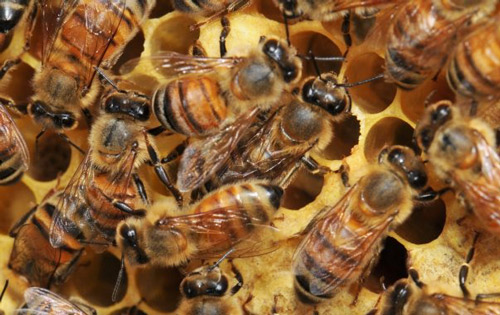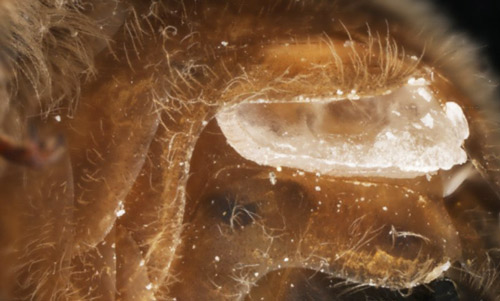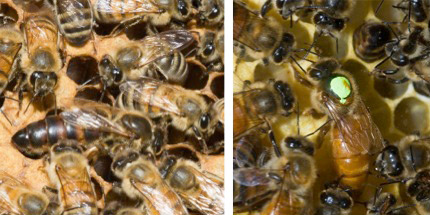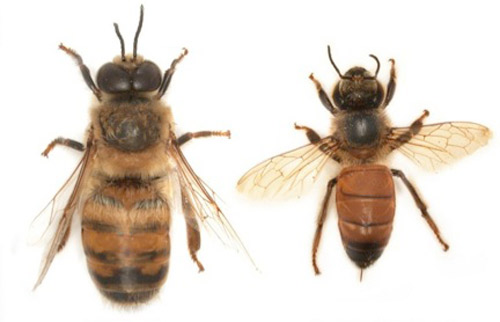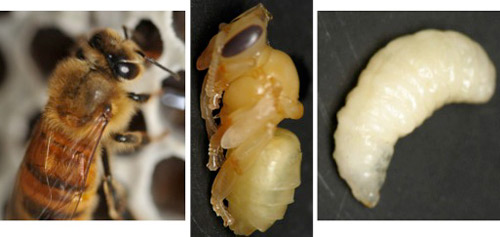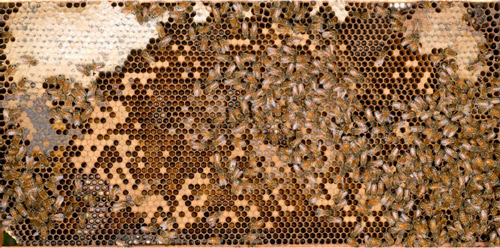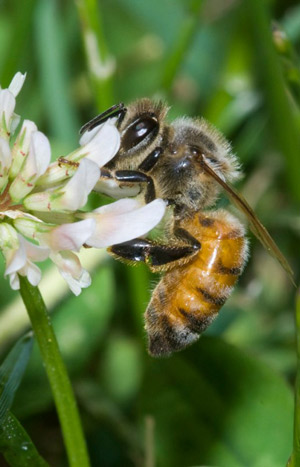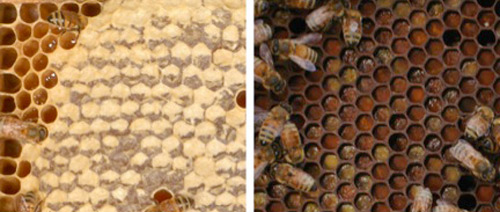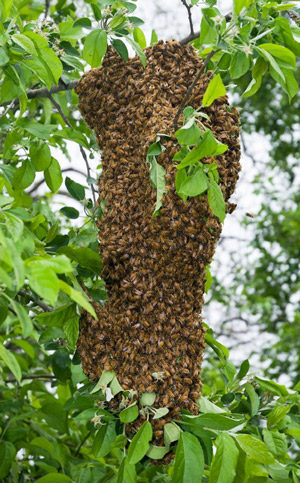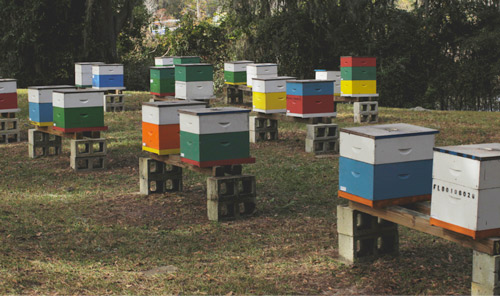common name: European honey bee
scientific name: Apis mellifera and subspecies Linnaeus (Insecta: Hymenoptera: Apidae)
Introduction - Distribution - Description - Biology - Life Cycle - Economic Impact - Management - Selected References
Introduction (Back to Top)
The western honey bee, Apis mellifera Linnaeus, naturally occurs in Europe, the Middle East, and Africa. This species has been subdivided into at least 20 recognized subspecies (or races), none of which are native to the Americas. However, subspecies of the western honey bee have been spread extensively beyond their natural range due to economic benefits related to pollination and honey production.
In the United States, “European” honey bees (Fig. 1) represent a complex of several interbreeding European subspecies including; Apis mellifera ligustica Spinola, Apis mellifera carnica Pollmann, Apis mellifera mellifera Linnaeus, Apis mellifera causcasia Pollmann, and Apis mellifera iberiensis Engel. Introduction of these subspecies dates back to early American settlers in 1622. More recently (late 1950s), a subspecies of African honey bee, Apis mellifera scutellata Lepeletier, that can interbreed with European subspecies was introduced into the Americas.
Figure 1. European honey bees, Apis mellifera Linnaeus, on comb in a colony. Photograph by Ashley N. Mortensen, Entomology and Nematology Department, University of Florida.
Public interest and participation in honey bee management (beekeeping) has increased since 2006 when the acute disappearance of worker bees from a colony was described as colony collapse disorder (CCD). Since that time, worldwide research efforts have focused on improving colony health and management techniques, and identifying possible causes of colony collapse disorder.
Distribution (Back to Top)
European races of Apis mellifera have been spread extensively beyond its natural range. Presently, European honey bees are naturalized on all continents except Antarctica.
Description (Back to Top)
Like all Hymenopterans, honey bees have haplo-diploid sex determination. Unfertilized eggs (no paternal genetic contribution) develop into drones (males), and fertilized eggs (both maternal and paternal genetic contribution) develop into females. Female larvae that are fed the standard diet of pollen, nectar, and brood food become adult workers. Female larvae fed a rich diet of royal jelly, pollen, and nectar develop into queens.
Worker honey bees are non-reproductive females. They are the smallest in physical size of the three castes and their bodies are specialized for pollen and nectar collection. Both hind legs of a worker honey bee have a corbicula (pollen basket; Fig. 2) specially designed to carry large quantities of pollen back to the colony. Worker honey bees produce wax scales on the underside of their abdomen. The scales are used to construct the wax comb within the colony (Fig. 3). Workers have a barbed stinger that is torn, with the poison sac, from the end of their abdomen when they deploy the sting into a tough-skinned victim. This results in the worker bee’s death.
Figure 2. Worker European honey bee, Apis mellifera Linnaeus, with pollen stored in the corbicula of both hind legs. Photograph by Susan E. Ellis, littleladiesofthehive.com (used with permission).
Figure 3. Wax scale being produced from the underside of a worker European honey bee’s, Apis mellifera Linnaeus, abdomen. Photograph by Susan E. Ellis, littleladiesofthehive.com (used with permission).
The queen honey bee (Fig. 4) is the only reproductive female in the colony during normal circumstances (some workers can lay unfertilized male eggs in the absence of a queen). Her head and thorax are similar in size to that of the worker. However, the queen has a longer and plumper abdomen than does a worker. The queen also has a stinger but its barbs are reduced. Consequently, she does not die when she uses it.
Figure 4. An unmarked queen European honey bee, Apis mellifera Linnaeus (left), and a queen who has been marked with a small dab of paint (right) on comb. Photograph by Susan E. Ellis, littleladiesofthehive.com (used with permission).
Drones are the male caste of honey bees. The drone’s head and thorax are larger than those of the female castes, and their large eyes appear more ‘fly-like,’ touching in the top center of the head. Their abdomen is thick and blunt at the end, appearing bullet-shaped rather than pointy at the end as with the female castes (Fig. 5).
Figure 5. Drone (male) European honey bee, Apis mellifera Linnaeus on the left and a worker European honey bee on the right. Photograph by Susan E. Ellis, littleladiesofthehive.com (used with permission).
All honey bees undergo complete metamorphosis. This means that they have distinct developmental stages (egg, larvae, pupa, and adult; Fig. 6). Typical developmental time from egg to adult varies by caste. Drones have the longest development (24 days), workers are intermediate (21 days), and queens are the fastest (15-16 days).
Figure 6. Life stages of a honey bee, adult (left), pupa (middle), larvae (right). Photographs by Jason Graham and Ashley N. Mortensen, University of Florida.
Eggs: Honey bee eggs measure 1 to 1.5 mm long and look like a tiny grain of rice. The queen lays eggs in individual hexagonal wax cells in the brood area of the comb (Fig. 7). After 3 days, eggs hatch and larvae emerge. Honey bee eggs can be difficult to see, but their presence indicates a laying queen is present in the colony (a very helpful tool when inspecting a managed honey bee colony).
Larvae: In the honey bee colony, larvae are referred to as “open brood” because the cells are uncapped (Figs. 6 and 7). The number of days a honey bee spends as a larvae varies by caste (worker: 6 days, drone: 6.5 days, queen: 5.5 days). Larvae are white and lay in a curled “C” shape at the bottom of their wax cell. When the mature larvae are ready to molt into pupae they extend their bodies into an upright position in the cell, and adult workers tending to the brood cover the prepupal larvae with a wax capping.
Pupae: Beneath the wax capping, prepupal honey bee larvae molt into pupae (Fig. 6). The pupae remain under the wax capping until they molt into an adult and chew their way out of the cell. Pupae are referred to as “capped brood” because the cells are capped (Fig. 7). Similar to the larval stage, pupal developmental time varies by caste (worker: 12 days, drone: 14.5 days, queen: 8 days).
Adults: Adult honey bees (Fig. 6) are covered in branched hairs and can be divided into three body regions: head, thorax, and abdomen (Fig. 8). The primary features of the head are the compound eyes and antennae. Two pair of wings and three pairs of legs that attach to the thorax. A slender ‘waist’ is created by a constriction of the second abdominal segment. The most notable external feature of the abdomen is the stinger. Only female honey bees have a stinger, as it originates from a modified ovipositor.
Figure 7. A frame of comb from a managed European honey bee colony containing all life stages of European honey bees, Apis mellifera Linnaeus, and worker bees tending to the developing brood. The queen can be seen in the lower right corner. Photograph by Jeffrey W. Lotz, Florida Department of Agriculture and Consumer Services - Division of Plant Industry.
Figure 8. Worker European honey bee, Apis mellifera Linnaeus, foraging on a flower. Note hairs covering the body, and the “waist” created by the constriction of the second abdominal segment. Photograph by Susan E. Ellis, littleladiesofthehive.com (used with permission).
European honey bees are not easily discriminated from the race of African honey bees present in the Americas. However, European honey bees are slightly larger than African honey bees. Laboratory personnel use morphometric analyses of wing venation patterns and the size of various body parts to differentiate European honey bees from African/Africanized honey bees. Additionally, genetic analysis can distinguish and identify interbreeding between subspecies.
Biology (Back to Top)
In the honey bee colony, labor is divided among individuals based on caste and age. A drone’s only purpose is to mate with a virgin queen from another colony. The queen is the sole egg layer in the colony and is responsible for producing all of the colony’s offspring (up to 1500 eggs/day). Worker honey bees are thusly named because they perform all colony maintenance tasks. Each worker will perform different tasks exclusively in a predictable order based on their age. This is called age-related polythism. The youngest workers tend the brood (eggs, larvae, and pupae) while older workers build wax comb, handle food stores within the colony (Fig. 9), and guard the colony entrance. The oldest workers are foragers; these are the honey bees people encounter most.
Figure 9. Honey (left) and pollen (right) being stored in wax comb within the colony. Photographs by Jeffrey W. Lotz, Florida Department of Agriculture and Consumer Services - Division of Plant Industry.
The cohesiveness of the honey bee colony is dependent on effective communication. Honey bees primarily communicate within the colony through chemical signals called pheromones. Workers, drones, and queens have various glands that produce pheromones. These pheromones include the queen mandibular pheromone that enables a colony to detect the presence of their queen, brood pheromones that signal the type of care required by the immature bees in the colony, and Nasanov pheromone (Figure 10) that communicates the location of the colony to workers who may have been displaced in a colony disturbance.
Figure 10. Worker European honey bee, Apis mellifera Linnaeus, exposing the Nasanov gland at the tip of the abdomen and fanning her wings to release Nasanov pheromone when the colony was disturbed by removing the lid. Photograph by Ashley N. Mortensen, University of Florida.
One of the most notable honey bee behaviors is stinging. Stinging is a defensive behavior worker bees use to protect the colony. When a colony intruder is detected, guard bees release an alarm pheromone that elicits a defensive response by the colony. Moreover, when a honey bee stings, it releases alarm pheromone to attract more bees to sting the location that was stung. All worker honey bees die after stinging, and European honey bees rarely sting without provocation.
Life Cycle (Back to Top)
Due to their highly social life history, honey bee colonies can be considered superorganisms. This means the entire colony, rather than the bees individually, is viewed as the biological unit. With that in mind, honey bees reproduce not by producing more individual bees, but rather by producing more colonies. The reproductive process of creating a new colony is called swarming.
European honey bees typically swarm in the spring and early summer when pollen and nectar resources are plentiful. To initiate the swarming process, 10 to 20 daughter queens are produced by the colony. When the daughter queens are in the late pupal stage, the mother queen and about 2/3rds of the adult workers leave the colony and travel to a location where they will coalesce (Figure 11) while they send scout workers in search of a place to establish a new colony (typically an enclosed cavity, like a tree hollow).
Figure 11. A reproductive swarm of European honey bees, Apis mellifera Linnaeus, coalesced on a tree branch while scout workers search for a place to establish the new colony. Photograph by Susan E. Ellis, littleladiesofthehive.com (used with permission).
The daughter queens in the original colony then emerge as adults and fight until a single queen remains alive, unless one queen emerges earlier than her sisters, in which case she will hunt for and kill her unborn siblings. After a short time of further maturation, the remaining daughter queen leaves the colony to mate with about 15 drones. All mating occurs in the first 2 weeks of a queen’s life, outside of the hive and in the air at drone congregation areas. The queen then stores the collected sperm in her spermatheca for the remainder of her life. Once successfully mated, the daughter queen begins laying eggs, thus completing both halves of the swarming process.
European honey bees are adapted to temperate climates, where there is only a short season with generous amounts of pollen and nectar available. For this reason, they typically swarm only once a year. The remainder of the spring/summer is devoted to collecting and storing enough nectar and pollen to generate the food stores needed to survive the fall and winter.
This behavior of resource hording is what makes European honey bees excellent honey producers. Nectar is collected from flowers and transformed into honey though enzymatic processes and dehydration within the colony. At this time, the honey is capped over in the wax comb where it can stay fresh almost indefinitely, depending on the original nectar source. Beekeepers and honey hunters may then collect this honey comb for human consumption.
Economic Importance (Back to Top)
European honey bees are an established component of the United States’ agricultural system. In fact, pollination by honey bees contributes significantly to global food production. Bees pollinate more that 30% of the food we eat, and in the United States is it estimated that bees pollinate up to $15 billion worth of crops each year. In addition to providing pollination services, honey bees also produce other products that people use including honey, pollen, wax, royal jelly, and propolis.
Management (Back to Top)
Honey bee management is popular worldwide and varies greatly in style and scale. Commercial beekeepers may maintain 2,000 or more colonies, whereas a hobbyist beekeeper may have as few as one. The equipment used to house honey bee colonies is also very diverse. Some of the more popular equipment styles include skeps, top bar, log gum, and Langstroth hives, with the Langstroth hive being the most widely used in the United States (Fig. 12). The Langstroth hive features interchangeable boxes (supers) with removable frames (combs) that allow for colony inspection, pest/disease treatment, and honey collection without destroying the colony.
Figure 12. An apiary of managed European honey bee, Apis mellifera Linnaeus, colonies in Langstroth hives. Photograph by Mary Kay Weigel, the University of Florida.
Honey bee pathogens and pests have been spread around the world with the movement of European honey bees. In the United States, European honey bees are susceptible to a wide range of viral, fungal, and bacterial infections including, but not limited to, Deformed Wing Virus, chalk brood, Nosema, European foulbrood, and American foulbrood. European honey bees also host natural pests, such as tracheal mites and wax moths, and introduced ones, such as small hive beetles (a honey bee pest from Africa) and Varroa mites (a honey bee parasite from Asia).
Beekeepers use integrated pest management strategies to maintain the impacts of the numerous pest- and pathogen-related problems below an acceptable threshold. Some of these control methods include selecting appropriate apiary locations, supplemental feeding, trapping pests in colonies, replacing queens, preventative treatments, and chemical control.
Figure 13. Nuisance colonies of European honey bees, Apis mellifera Linnaeus. Left: worker honey bees at the entrance of a colony in the exterior wall of a house. Right: the underside of a carport roof has been cut away to expose the wax combs of a colony. Photographs by Anthony Vaudo, University of Florida.
Honey bee colonies themselves also can be considered a pest when a feral swarm establishes a new colony in an undesirable location, such as the wall of a house, a mail box, or some other location where they will come into frequent contact with humans (Figure 13). In this case, a trained professional or beekeeper should be contacted to remove the nuisance colony.
Selected References (Back to Top)
- Atkins EL. 1975. The Hive and The Honey Bee. Dadant & Sons, Hamilton, Illinois, USA. 1324 pp.
- DeBerry S, Crowley J, Ellis JD. (November 2012). Swarm control for managed beehives. EDIS. (19 July 2013)
- Delaplane KS. 2007. First Lessons in Beekeeping. Dadant & Sons, Hamilton, Illinois, USA. 166 pp.
- Denmark HA, Cromroy HL, Sanford MT. (August 2006). Honey bee tracheal mite, Acarapis woodi (Rennie) (Arachnida: Acari: Tarsonemidae). EDIS. (19 July 2013)
- Ellis A, Ellis JD, O’Malley MK, Zettle Nalen CM. (September 2012). The benefits of pollen to honey bees. EDIS. (19 July 2013)
- Ellis JD. (July 2010). Colony Collapse Disorder (CCD) in honey bees. EDIS. (19 July 2013)
- Ellis JD, Ellis A. (November 2012). Apis mellifera scutellata Lepeletier (Insecta: Hymenoptera: Apis). Featured Creatures. (19 July 2013)
- Ellis JD, Ellis A. (June 2013). Aethina tumida Murray (Insecta: Coleoptera: Nitidulidae). Featured Creatures. (19 July 2013)
- Ellis JD, Zettel Nalen CM. (June 2013) Varroa destructor Anderson and Trueman (Arachnida: Acari: Varroidae). Featured Creatures. (19 July 2013)
- Hodges A, Mulkey D, Philippakos E, Fairchild G, Sanford M. 1999. Economic Impact of the Florida apiculture industry EDIS. (19 July 2013)
- Jürgen T. 2008. The Buzz about Bees: Biology of a Superorganism. Springer-Verlag, Berlin Heiderberg, Germany. 284 pp.
- Moritz RFA, Southwick EE. 1992. Bees As Superorganisms: An Evolutionary Reality. Springer-Verlag, New York, USA. 395 pp.
- O’Malley MK, Ellis JD. (January 2012). Choosing the right pest control operator for honey bee removal: A consumer guide. EDIS. (19 July 2013)
- Root AI. 1975. The ABC and XYZ of Bee Culture. A. I. Root Company, Medina, Ohio, USA. 911 pp.
- Sheppard WS. 1989a. A history of the introduction of honey bee races into the United Sates: Part I. American Bee Journal 129: 617-619.
- Sheppard WS. 1989b. A history of the introduction of honey bee races into the United Sates: Part II. American Bee Journal 129: 664-667.
- Winston ML. 1987. The Biology of the Honey Bee. Harvard University Press, Cambridge, Massachusetts, USA. 281 pp.
- Sanford MT. (September 2011). Wax moth control. EDIS. (19 July 2012)
